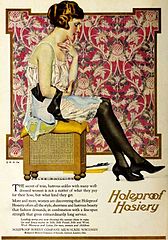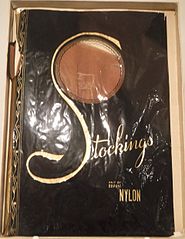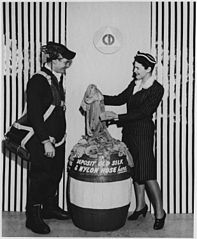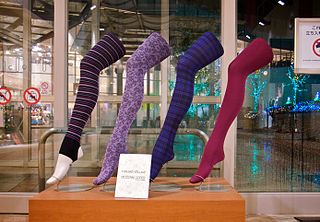
In 2009 journalist Gail Collins wrote a Letter to Young American Women, advising them that if they had come of age in 1960 they would feel more restricted, “if only because you were doomed to spend you days in a skirt, nylon stockings and girdle. (Everybody wore a girdle back then, even Barbie, the individual least in need of a foundation garment in American history.)”
Fast forward to the 1970s. Women wore nylon panty hose under pant suits to the office. The concept that a woman’s bare leg was unattractive was deeply entrenched.

Women had always worn stockings, most often for warmth. Up until about 1910, it didn’t matter how the stockings looked, because no one could see them under long skirts. Prior to the 1890s, stockings were made from cotton, linen, wool, or silk. None of these fabrics adhered to a woman’s leg. They bunched, wrinkled, and may have itched.
Skirts got a little shorter in 1910 with hemlines above the ankle. Hence the line from Cole Porter’s 1934 song Anything Goes:
“In olden days a glimpse of stocking was looked on as somethng shocking but now, God knows, anything goes.”

Hemlines took a serious rise in the 1920s, and women wanted sheer stockings to cover their exposed legs. Typical stockings came just above the knee and were secured by a garter. Suspension belts, also known as garter belts, had been invented in 1912. This 1921 advertisement from the Holeproof Hosery Company illustrates the desired effect. Despite their expense and tendency to run, by the 1930s, silk and rayon stockings were essential to a woman’s wardrobe.

On May 16, 1940 a new stocking came on the market when DuPont revealed nylon stockings with a nylon leg; a silk upper welt, toe, and heel, and a cotton seam at the back. Seams, by the way, had to be worn exactly straight in the middle of the leg. Four million pairs of brown nylon stockings appeared on department store shelves priced at $1.15 a pair. They sold out in two days. Women loved the fit, feel, and versatility of nylon stockings. They didn’t feel properly dressed without them.

On December 8, 1941 the United States entered World War II, and nylon became a vital war material used for parachutes, tire cords, ropes, aircraft fuel tanks, shoe laces, mosquito netting, and hammocks. Nylon stockings disappeared, and women were asked to launder their stockings and put them in a bin to be recycled into gun powder bags. The caption on this recycling barrel reads: “Worn out nylon and silk stockings in this barrel full of salvaged stockings will be reprocessed and made into parachutes for army flyers, tow ropes for glider planes.”
Women were appalled at the idea of appearing in public with bare legs and socks and did everything they could to restore the look of stockings. They stained their legs with gravy browning mixtures, coffee, and cocoa powder. They used eyebrow pencil to draw a “seam” up the back of their legs. They shaved their legs, a grooming habit that hadn’t previously caught on.
Finally, the war was over. The song, When Nylons Bloom Again from Ain’t Misbehavin’ reflected the mood:
“I’ll be happy when nylons bloom again
Cotton is monotonous to men
Only way to keep affection fresh
Get some mesh for your flesh”
In August 1945, DuPont announced it would begin producing nylon stockings, but there were production delays. In September, mobs of women entered stores demanding nylons. Macy’s sold 50,000 pairs of stockings in six hours. There were Nylon Riots in Pittsburgh where 40,000 customers lined up for over a mile. The store only had 13,000 pairs of stockings. Things got ugly. The nylon shortage continued into 1946, but by March DuPont was able to produce 30 million pairs of nylon stockings a month.

Hosery fashion has moved on since 1960. Women still wear nylon stockings that come in multiple styles and colors. They also wear leggings, tights, leg warmers, and socks. They wear pantyhose, garter tops, knee high, and stay-up stockings. And sometimes, women don’t cover their legs at all.
???
When Nylons Bloom Again by George Markon, Jr. and Fats Waller.
1922 Holeproof Hosiery Advertisement
1910 Women’s Suit Hat
1921 Holeproof Hosiery Advertisement
Original Package of DuPont Stockings from the Science History Institute
Worn Out Nylons. NARA
“Which one do you like the most?” [Leggings] by mxmstryo
Gail Collins. “Letter to young American women.” CNN. Nov. 2, 2009.
Katelyn Merrigan. “History of Hosiery.” VienneMilano. July 17, 2017.
Emily Spivack. “Stocking Series, Part 1.” Smithsonian. Sept 4, 2012.

Sandra Wagner-Wright holds the doctoral degree in history and taught women’s and global history at the University of Hawai`i. Sandra travels for her research, most recently to Salem, Massachusetts, the setting of her new Salem Stories series. She also enjoys traveling for new experiences. Recent trips include Antarctica and a river cruise on the Rhine from Amsterdam to Basel.
Sandra particularly likes writing about strong women who make a difference. She lives in Hilo, Hawai`i with her family and writes a blog relating to history, travel, and the idiosyncrasies of life.


As always, very interesting! I do love history, and you make it alive.